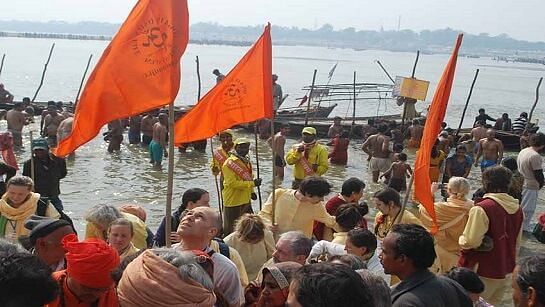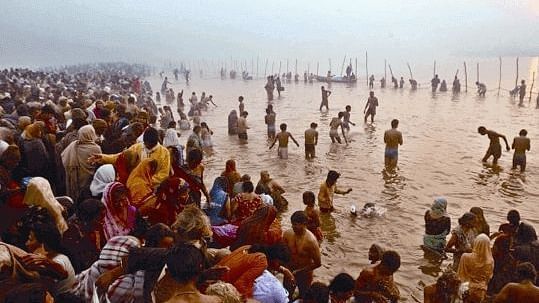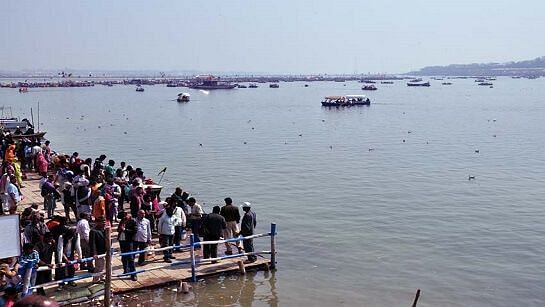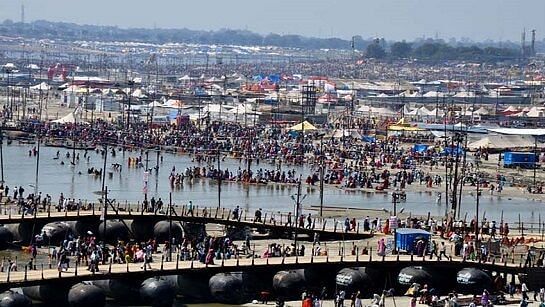The word prayaga has been traditionally used to mean "a confluence of rivers". It denoted the physical meeting point of the rivers Ganges & Yamuna in the city. An ancient tradition has it that a third river, invisible Sarasvati, also meets there with the two. Today, Sangam is a more frequently used name for the confluence.
Prayagraj meaning "the king among the five prayagas", is used as a term of respect to indicate that this confluence is the most splendid one of the five sacred confluences in India.
The city which has been innumerably mentioned in the ancient Hindu texts, and the history of the place, both mythological and factual that makes it one of the most fascinating and one among the main holy cities in India, special to the hearts of Hindus in India and abroad. It’s the mythological history according to which, when Lord Brahma was done with creating the world, offered his first sacrifice here. Hence the justification of its ancient name Prayag, meaning Place of Sacrifice. The place also holds a special significance according to the Hindu scriptures for holding the confluence of three of the most sacred rivers of India: Ganga, Yamuna, and Saraswati at Triveni Sangam, which becomes the nucleus of all celebrations of Kumbh Mela.
It is believed in the ancient times during an ongoing war between the demons and the demigods for the possession of the elixir of immortality, a few drops fell to earth at four places: Prayagraj, Haridwar, Nasik, and Ujjain. And it is at each of the four places that Kumbh Mela, the gathering of millions: devout and common witnesses from all over India and rest of the world, is held and is a sight like no other. Based on astrological calculations it returns to each place after a gap of twelve years, bigger each time.
The story that the drops of nectar of immortality fell near Sangam is believed by the people to have given mystical powers to the place as millions gather at the ghats to purge themselves of all sins by taking a dip in the waters and attain Moksha (Salvation). Young and old, fit and frail; all regions, castes, and creed aside, it becomes the single most brilliantly unifying experience ever. The place itself, overrun by Naga Sadhus, who never wear any clothes and are always smeared in ash; Urdhwavahurs, non-indulgent in physical pleasures; Parivajakas, having taken a vow of silence; and Shirshasins, who stand for all 24 hours and meditate, transforms as if from another realm.
Celebrations At Prayagraj Kumbh Mela
The Kumbh Mela at Prayag is widely considered as the most significant among all the Kumbh festivals held at other locations. It is considered as the source of light and knowledge. It is believed that Prajapati Bramha performed Ashvamedha Yajna at Dashashvamedha Ghat situated at the confluence of the Ganga and Yamuna and created the universe due to which it is the most famous and significant among all other Kumbh festivals.
Elemental meaning of Kumbh is:
• The confluence (Sangam) of all the cultures in the universe.
• A spiritual conscience.
• The flow of humanity.
• The flow of rivers, forests, and Rishi culture.
• The flow of life.
• The communion of nature and human life.
• The source of energy.
• The path of enlightenment.
Organising any event entails a massive marketing campaign, promotional activities, and sending invitations to guests. The Kumbh Mela is perhaps the only event in the world where no invitation is required yet millions of pilgrims gather to celebrate the holy event.
Pilgrims to the Kumbh Mela come from all sections of the religion ranging from Sadhus (saints) and Naga Sadhus who practice ‘sadhana’ and keenly follow a strict path of spiritual discipline, to Hermits who leave their seclusion and come to visit the civilization only during the Kumbh Mela, to seekers of spirituality, and to common people practicing Hinduism.
During the Kumbh Mela, a number of ceremonies take place; the traditional procession of Akharas called ‘Peshwai’ on elephant backs, horses and chariots, the shining swords and rituals of Naga Sadhus during ‘Shahi Snaan’, and many other cultural activities that attract millions of pilgrims to attend the Kumbh Mela.
Apart from its primary bathing rituals, the social aspect of the festival also revolves around the various Yajnas, the chanting of Vedic Mantras, holy elucidations, traditional dances, devotional songs, programs based on mythical stories, and prayers. Religious assemblies are held where doctrines are debated, standardized and conducted by renowned saints and sages. A prominent part of the festival is the act of donations to the poor and helpless, to the saints, and to cows. Donations range from basic food and clothing to even precious metals.
The welfare of all beings, sharing of noble thoughts and maintaining good relationships with all the beings across the world is the core message prevalent during the Kumbh festival. Kumbh has been spiritually uniting the people of India and across the world since time immemorial and will continue doing so for years to come.
Prayagraj Maha Kumbh Mela 2025 major Bathing Dates
The Kumbh Mela comprises of many rituals including bathing ritual, which by far is the most significant ritual performed at Kumbh. Millions of pilgrims take part in the Kumbh bathing ritual at the Triveni Sangam. Performing this sacred ceremony is in accordance with the belief that by submerging oneself in the holy waters, one is purged of all their sins, release themselves and their ancestors from the cycle of rebirth and ultimate attainment of Moksha. Along with the bathing ritual, the pilgrims also worship on the banks of the holy river and participate in discourses from various sadhus and saints.
Although taking a dip in the sacred waters on all days of Prayagraj Kumbh beginning from Makar Sankranti (first day of the month of Magh, when the Sun enters Capricorn) is considered holy, yet there are some specific auspicious bathing dates. There are magnificent processions of saints and their disciples, and members of various Akharas (religious orders) take part in the ritual of Shahi Snan also known as ‘Rajyogi Snan’ at the start of Kumbh. Shahi Snan is the central highlight of Kumbh Mela and the most important part of the celebration. It is only after the Shahi Snan is complete, that people are allowed to take the holy bath, in the belief that the people will get the added advantage of the essence of holy deeds and thoughts of the saints by taking the dip after them.
| Date (2025) | Day | Event |
| 13th January | Monday | Paush Purnima |
| 14th January | Tuesday | Makar Sakranti ( 1st Shahi Snan) |
| 29th January | Wednesday | Mauni Amavasya Main Royal Bath (2nd Shahi Snan) |
| 3rd February | Monday | Basant Panchami (3rd shahi Snan) |
| 12th February | Wednesday | Maghi Poornima |
| 26th February | Wednesday | Maha Shivratri |
Paush Purnima
Paush Poornima is the 15th day in the month of Shukla Paksh of the Hindu calendar month Paush. Poornima signifies the rise of the full moon. The Kumbh Mela’s unofficial beginning is marked by this day. This day also marks the beginning of Kalpvasa


Makar Sankranti
This day marks the entry of Sun in its next astronomical position as per the Hindu calendar. This day marks the beginning of donations at Kumbh Mela. It is customary for pilgrims to donate as per their will.
Mauni Amavasya
It is widely believed that on this date the planetary positions are most favorable for bathing in the holy river. On this day, Rishabh Dev, considered as the first sage broke his long vow of silence and bathed in the holy waters at Sangam. Maximum number of pilgrims Visit Sangam this day.


Basant Panchami
This day is indicative of the changing of seasons and marks the arrival of Goddess of Knowledge Saraswati as per Hindu Mythology. Kalpavasis wear yellow colored clothes this day to mark the importance of Basant Panchami.
Maghi Purnima
This day is known for its association with the worship of Guru Brahaspati and the belief that Hindu god Gandharva travels from the heavens to Sangam. This day sees a surge in pilgrims at the holy ghats owing to the belief that they will be guided to heaven in their humanly form.


Mahashivratri
This day is symbolic of the last holy bath of the Kalpvasis and is directly related to Lord Shankar. As per mythology, this day is awaited in the heavens as well.